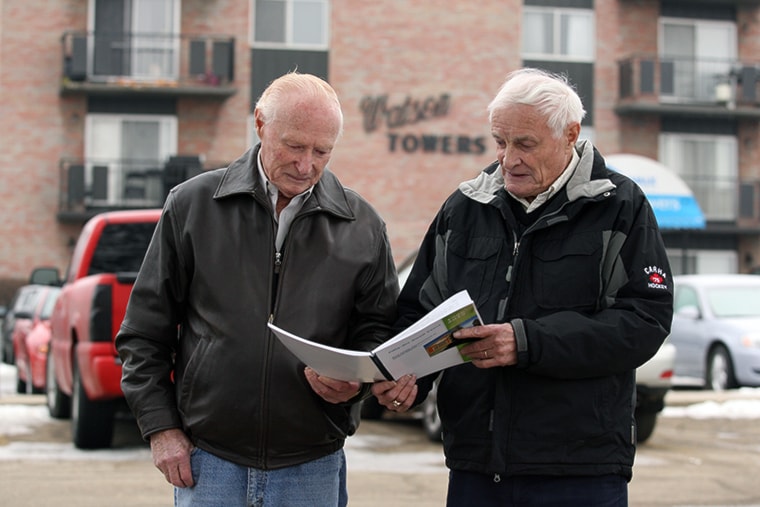In 1934, a destitute Saskatchewan farmer threw a piece of canvas over a hayrack, loaded his young family and abandoned his drought-stricken homestead in favour of greener prospects in Central Alberta.
Among the passengers in the horse-drawn wagon were a pair of infants who would do much to shape the appearance of Red Deer.
Now 82 and 80 respectively, Alan and Gene Watson have had a hand in dozens of local development projects — including Morrisroe subdivision, Village Shopping Centre, Checkmate Court, Centre 53, Watson Towers, The Watson Centre and Plaza 52nd Street.
They remember growing up on 40 acres of farmland near Pine Lake, where their father settled after arriving in the midst of the Depression.
“Apparently, he was heading for Sylvan Lake and he got lost or some damn thing and ended up at Pine Lake,” said Gene.
He and Alan recounted how they and two other siblings rode horseback 4 1/2 miles to the Pine Lake school, including on frigid winter days when the ink wells in their uninsulated school house would freeze.
Alan quit school in Grade 9 to do farm work. Gene stuck it out to the midway point of Grade 12, and then followed suit.
By the early 1950s, both had found work with local plumbing companies: Gene at Burnett Plumbing and Alan at Hayhoe Plumbing. Soon after, they took their first tentative step into the development business, buying a pair of vacant lots in Blackfalds for $100 each.
Gene recalled having to negotiate terms with town council after he and his brother realized they only had $100 between them. They started building a house on one of the lots, working evenings and weekends.
“It took all summer to build the basement,” said Gene, adding that framing proceeded as they scraped together the money for lumber.
Proceeds from the sale of that first house financed a second, and the Watsons were on their way.
In 1957, Gene started Watson Plumbing after earning his plumbing ticket. Alan joined him after doing the same, and Watson Bros. Plumbing Ltd. was the result.
They began building in earnest in the early 1960s, with several multi-family residential projects and a small commercial building. They also bought Marshall Wells Hardware Store in Sylvan Lake, reasoning that the business would generate plumbing work for them around town.
Their days often started at 6 a.m. and didn’t wrap up until 8 or 9 at night. But they continued to build, and in 1965 obtained a 50 per cent interest in construction company Swell Investments Ltd., later buying the balance of the company.
Subsequent projects included commercial buildings, apartment buildings and townhouse complexes. In 1975, the Watsons bought 20 acres of farmland from Jim Morrisroe and subdivided it into 75 residential lots.
They soon realized that land development could be a risky venture, with builders reluctant to buy lots from them.
“Alan and I were so down,” said Gene. “We had millions tied up in these lands.”
A critical point came when Gene met with an official from a large construction company, who seemed cool to the idea of investing in the Watsons’ subdivision.
“Pretty soon he says, ‘I’ll take about 35 lots.’ I could have jumped across the desk and kissed him.”
The Watsons might have dodged another bullet a few years later, after purchasing the land where Checkmate Court now stands. They intended to build a pair of 15-storey residential buildings there.
“We were just ready to get the permits out,” said Alan. “We were all ready to go.”
But, nervous about the huge financial commitment, they postponed the project in favour of Michener Manor condominium, and ultimately sold the property to another developer. It went bankrupt during construction of Checkmate Court, and a subsequent developer lost the building to foreclosure — a victim of Alberta’s economic collapse in the early 1980s.
The Watsons ended up buying the apartment building in 1986 and eventually condominiumized it.
They weren’t so lucky when they bought what appeared to be a prime piece of land west of Red Deer’s downtown, with plans to build an eight-storey condominium. It turned out that soil on the property had been contaminated by fuel from a nearby service station, rendering it unsuitable for residential development and forcing the brothers to sell at a loss.
“That was a real kick in the ass,” said Gene, describing the situation as the worst he and Alan encountered during their more than half a century in the development business.
They also faced some adversity in the early 1980s after developing Village Shopping Centre with two other business partners. The economic downturn pushed the cost of their financing to around 25 per cent, and chased many of their tenants away.
“We’d go up and have coffee and talk to them; next morning, you’d go there and they’d be gone,” said Gene.
The Watsons eventually secured a more favourable loan, and in 1984 traded Village Shopping Centre for a number of other commercial and residential properties.
The brothers have now sold their real estate holdings, with Watson Centre the last to go in 2012. They still have an office in that building, but aren’t sure how long they’ll remain.
Recently, the Watsons produced a 52-page book chronicling their days in the development business. Most of the 125 copies are being delivered to many of the people Alan and Gene worked with over the years, but several have gone to the Red Deer Archives, where members of the public can view them.
hrichards@www.reddeeradvocate.com
